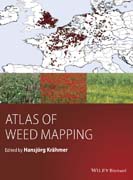
Weeds are variously defined as plants growing where they are not wanted, plants that interfere with human activity. Weeds affect everyone in the world by reducing crop yield and quality, delaying or interfering with harvesting, interfering with animal feeding, reducing animal health, preventing water flow, as plant parasites, etc. It is estimated that those problems cause $ billions worth of crop losses annually and the global cost of controlling weeds also runs into many $ billions every year. Atlas of Weed Mapping presents an introductory overview on the occurrence of the most common weeds of the world. The book notably includes: Description of cropping practices and explanations for the global distribution of weeds Invasive plant mapping Aquatics and wetland plants with histological plant details Theoretical and practical aspects of weed mapping Aspects on the documentation of herbicide resistance Biodiversity, rare weeds and the dominance of the most common weeds Fully illustrated with more than 800 coloured figures and a number of tables, this new characterisation of anthropogenic vegetation will be interesting for readers of a great number of disciplines such as agriculture, botany, ecology, geobotany and plant community research. More than a hundred experts have contributed data to this unique compilation. INDICE: Acknowledgements .Introduction .Part I: Continental views of weed infestation mapsH. Kraehmer .Chapter 1. Europe .Wheat .Maize .Oilseed rape .Chapter 2. Asia .Rice .Wheat .Maize .Chapter 3. North America .Maize .Soybean .Wheat .Canola .Chapter 4. South America .Soybean .Maize .Sugar cane .Wheat .Chapter 5. Africa .Wheat .Maize .Cassava .Chapter 6. Australia .Wheat .Part II: Special crop view / mapping of cotton weedsG. Economou, A. Uludag, H. Kraehmer .Chapter 7. Cotton cultivation .Chapter 8. Global cotton weed distribution .Chapter 9. Farming practices and weed infestation .Chapter 10. Summary on global cotton weed distribution .Part III: Invasive weed speciesH. Kraehmer .Chapter 11. Overview on selected problems .Part IV: Global zones with similar weed infestationH. Kraehmer .Chapter 12. Introduction .Chapter 13. Cereal weed belts .Chapter 14. Maize weed belts and areas of similar weed infestation .Chapter 15. Soybean weed zones and areas .Chapter 16. Rice weed belts .Part V: General observations over all infested sitesH. Kraehmer .Chapter 17. Ranks and number of weed species in a defined crop .Chapter 18. Specialization of weeds and biodiversity .Part VI: Answers to key questions: What makes which weed grow where and when?H. Kraehmer .Chapter 19. Weeds as crop companions .Chapter 20. Can we associate weeds with specific environmental conditions? .Chapter 21. What makes weeds grow in monocultures, what makes them compete with the crop and with other weeds? .Part VII: Aesthetics, rare weeds and production objectives in agricultureH. Kraehmer .Chapter 22. Rare weeds in arable crops and aesthetics Harmony or hunger? .Part VIII: Weeds in meadows, pasture and rangelandH. Kraehmer .Chapter 23. Overview .Part IX: Aquatic and wetland weedsH. Kraehmer .Chapter 24. Introduction .Chapter 25. Morphological adaptation to water .Chapter 26. Aerenchyma within the stem .Chapter 27. Stem and vascular bundle modifications .Chapter 28. The root .Chapter 29. The leaf .Chapter 30. Vegetative propagation .Chapter 31. Aesthetics, species attractiveness and rare aquatic species .Chapter 32. Growing conditions of aquatic plants .Chapter 33. Dominance and noxious effects of selected aquatic and wetland species .Chapter 34. Adaptation of terrestrial weeds to water stress .Chapter 35. Weeds in rice .Part X: Which ecological rules described in textbooks will help us to understand the unevenness of weed species distribution?H. Kraehmer .Chapter 36. Asymmetric competition within arable crops .Chapter 37. Comparison of closely related species and their ability to grow as weeds in crops .Part XI: Factors contributing to the spatial distribution of weed resistance a map based analysisMartin Hess, Johannes Herrmann, Hansjörg Krähmer and Roland Beffa .Chapter 38. How does Alopecurus myosuroides resistance change over years? .Chapter 39. Weeds to watch .Part XII: Conflict between the dominance of some weeds and the intention to preserve rare speciesH. Kraehmer .Chapter 40. Can we shape nature as we want it to look like? .Part XIII: Weed data collection, analysis and presentation of resultsM. Koláøová and P. Hamouz .Chapter 41 Introduction to weed mapping methodology .Chapter 42 Data collection .Chapter 43 Approaches to the analysis of weed distribution .Chapter 44 Presentation of weed mapping results .Part XIV: Attachments .Index
- ISBN: 978-1-118-72073-8
- Editorial: Wiley–Blackwell
- Encuadernacion: Cartoné
- Páginas: 576
- Fecha Publicación: 01/04/2016
- Nº Volúmenes: 1
- Idioma: Inglés
